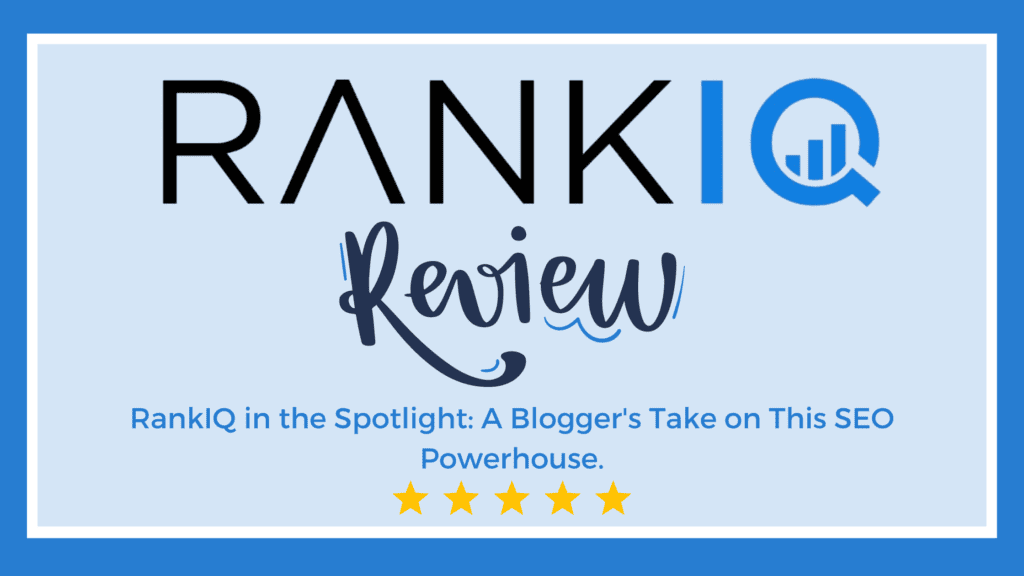Unlocking the Power of RankIQ For New Bloggers
Delve deep into the world of RankIQ and discover how this state-of-the-art SEO tool can revolutionize your blogging journey. From optimizing old blog posts to crafting compelling new content, RankIQ offers a plethora of features tailored for both new and experienced bloggers.
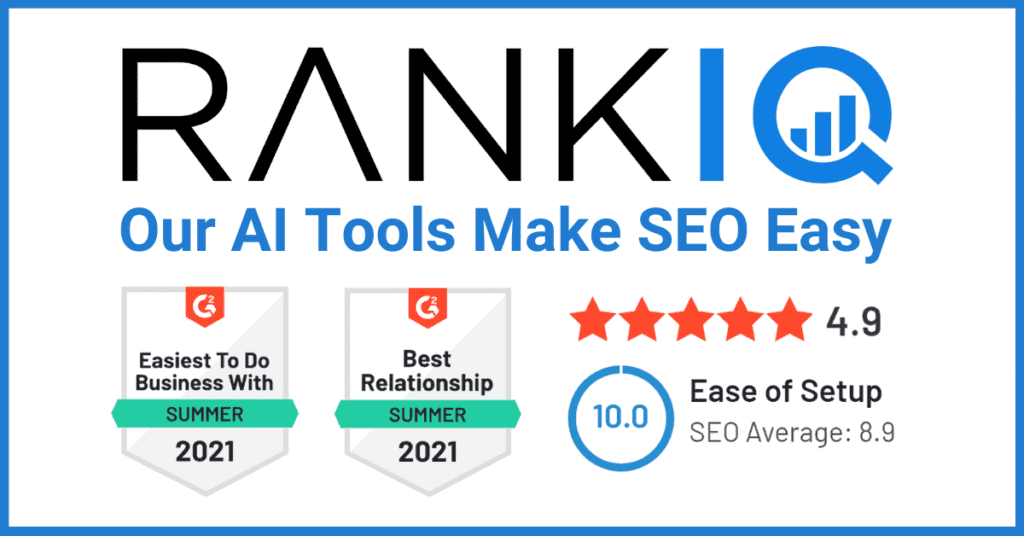
Your First Glimpse at RankIQ
Ready to Dive In?
Dive deeper into the review to fully harness RankIQ's potential for your blog.
What is RankIQ?
If you’re diving into the world of content creation or running a small business, understanding and implementing SEO can be an intimidating challenge.
Enter RankIQ, a powerful tool that’s about to revolutionize how you approach SEO.
RankIQ is an AI-driven platform, tailored specifically for bloggers and small businesses.
Unlike many of its competitors, RankIQ shines in its simplicity and precision.
It’s been designed from the ground up to demystify the complex labyrinth of SEO, turning it into actionable, understandable steps.
As we delve deeper into this review, you’ll discover why RankIQ is rapidly becoming the go-to SEO tool for individual bloggers and businesses alike.
So, if you’re ready to elevate your content game and master the nuances of SEO without getting bogged down by technical jargon, read on.
Skip Straight To How RankIQ Works!
We understand that some of our readers are well-versed in the fundamentals of SEO and might be eager to dive right into the specifics of how RankIQ works. If that sounds like you, feel free to skip the foundational introduction and jump straight to the heart of our review.
A New Blogger's Dilemma
Every new journey begins with a first step, and for me, it was no different.
I remember crafting my very first blog post with an amalgamation of excitement and anticipation, waiting for the world to witness my creation.
Yet, as days turned into weeks, weeks into months…
The harsh reality began to seep in – the world of search engines was a vast and intricate maze that I had yet to navigate.
My posts, though filled with passion, were barely visible in the ever-expanding ocean of content.
The role of a new blogger is both exhilarating and daunting. Every fresh article feels like an achievement, and every new blog post brings with it the hope of reaching a wider audience.
But somewhere between mastering content creation and understanding the mysteries of search engines, I felt lost.
After publishing numerous posts without seeing any traffic, I came to understand that simply producing content wasn’t enough to ensure visibility.
The algorithmic gods needed more than just heart and soul; they demanded structure, relevance, and impeccable optimization. The process seemed intimidating, and with each attempt to decipher it, the maze grew denser.
Then, amidst all the confusion, I stumbled upon a Twitter post that introduced RankIQ as a tool for those new to blogging.
Touted as an AI SEO tool designed explicitly for beginner bloggers, RankIQ promised a simplified approach to the otherwise complex world of SEO.
Just as a lighthouse guides ships through treacherous waters, RankIQ became my beacon in the vast sea of SEO, illuminating the path towards creating new content that not only resonated with my audience but also sat well with search engine algorithms.
In the subsequent sections, we’ll take a closer look at how RankIQ offers a breath of fresh air to aspiring bloggers, simplifying the SEO landscape and ensuring their hard work doesn’t get lost in the digital shuffle.
This is an honest RankIQ review based on my personal experiences, written from the perspective of a newbie who had ZERO experience in the art of SEO.
A Special Mention: Brandon Gaille & the Blogging Millionaire Podcast
No exploration of RankIQ would be complete without mentioning the visionary behind it, Brandon Gaille.
As the host of the Blogging Millionaire podcast, Brandon brings to the table years of expertise and insights.
His podcast episodes have become essential listening for every top blogger looking to refine their SEO strategies and online presence.
RankIQ is the culmination of his vast knowledge, ensuring every user benefits from the distilled wisdom of a leading industry expert.
Understanding the Power of Search Engines
Before we delve into the features of RankIQ in this review, let’s take a moment to understand why search engines are so important for bloggers.
Search engines have evolved into the primary gateway for information, products, and services in our digitised world.
Whether you’re looking for the latest tech gadget or researching a vintage recipe from your favourite food blogger, chances are you’ll turn to a search engine to guide your discovery.
But what is it that makes these platforms so powerful and indispensable?
What Makes Search Engines Tick
Navigating the intricate pathways of search engine optimization can be an enormous task.
At their core, search engines are vast digital libraries. But instead of books, they catalogue web pages, videos, images, and more.
How they do this is a fine blend of technology, mathematics, and user psychology.
When a user punches in a query, search engines swiftly scour their indexed content to provide the most relevant search results.
But relevance isn’t just about matching words or hitting a specific target keyword.
Algorithms, the mathematical formulas that drive these engines, consider numerous factors like the quality of content, how recent it is, and how other web users interact with it.
One of the most sought-after metrics for any website owner is their Google rankings. Higher rankings mean more visibility, translating to increased organic traffic.
Organic traffic is the holy grail of SEO. It’s those users who land on your page as a direct result of their search query, without the influence of paid advertisements.
These rankings are influenced by various factors, from the use of keywords and the quality of content to the website’s mobile-friendliness and loading speed.
This type of traffic is often regarded as the most valuable because it’s both free and tends to bring in users genuinely interested in what you offer.
Why Every New Blogger Should Care
The blogosphere is a bustling, dynamic space.
Every day, new bloggers emerge, each bringing their unique voice and perspective. With such a saturated market, standing out is no easy feat.
For new bloggers, understanding search engines is more than just a technological exercise; it’s a survival skill.
When you produce content, you aren’t just writing for your audience; you’re also communicating with search engine algorithms.
As a content creator, you have a dual responsibility. Firstly, to create engaging, relevant content for your readers.
And secondly, to ensure that your masterpiece is discoverable in the vast sea of information.
This involves optimizing your content for search engines, ensuring you get a good content grade – a measure of how well your content is likely to perform in search results.
In other words, the relationship between bloggers and search engines is symbiotic.
While bloggers provide fresh, quality content for search engines to index, the search engines, in return, provide a platform for bloggers to reach a wider, more targeted audience.
Climbing to the First Page of Google with RankIQ
Every blogger dreams of reaching the pinnacle of search results—the elusive first page of Google.
This coveted spot ensures maximum visibility and a significant uptick in organic traffic. But with millions of content pieces competing for attention, how does one carve out a niche and secure a place on this revered page?
RankIQ is your knight in shining armour.
How RankIQ Supercharges Your Content
The importance of high-quality content cannot be overstated. While content is king, context is its queen.
Crafting content that provides value to the reader, while also ticking off SEO checkboxes, is paramount.
RankIQ offers tools and unique features to help you ascend to the 1st page of Google.
Traditionally, navigating tools like Google Search Console and Google Analytics has been a daunting task for new bloggers. They’re packed with data, graphs, and metrics that can seem like a foreign language to the uninitiated.
But RankIQ simplifies this process. Think of it as doing the heavy lifting for you, by extracting actionable insights from these complex platforms and presenting it to you in a digestible format.
It serves all the information that is important to SEO on a silver platter. Meaning less time spent scratching your head over complex search algorithms, and more time spent crafting posts that can rank highly on Google.
In the upcoming sections of this RankIQ review, we’ll delve into how RankIQ bridges the gap between new bloggers and search engines, ensuring your content doesn’t just reach the masses but resonates with them.
How RankIQ Works
Artificial intelligence has revolutionized many industries, and SEO is no exception.
Building on the foundation of AI’s transformative impact on SEO, RankIQ takes this innovation a step further, converting complex algorithms into actionable insights for bloggers.
The brilliance of Rank IQ is in the entirety of its SEO toolset.
Each RankIQ tool is fine-tuned to help bloggers optimize their content for search engines effectively.
But how exactly does RankIQ facilitate this seamless integration of AI-driven suggestions into the everyday routines of bloggers?
Within this section, we’ll look at a detailed walkthrough of RankIQ’s methodical approach to ensuring your content doesn’t just get seen—it gets noticed.
I’ll also drop some of the most commonly asked questions that RankIQ users have within the first month of signing up. This should help answer some of the burning questions you might be thinking ahead of time, before you sign up with RankIQ.
The RankIQ Workflow
Keyword Planning
Unlimited access to a hand-picked library filled of low competition, high traffic keywords.
AI SEO Report
SEO content brief identifies the topics that Google's ranking algorithm wants you to cover.

Content Optimizer
All-in-one writing assistant to write blog posts that can rank for on the 1st page of Google.
Step 1: Choose a Keyword from the Keyword Library
One of RankIQ’s standout features is its comprehensive keyword library.
Traditional keyword tools offer lists based on popularity or broad matches, but RankIQ delves deeper.
Its extensive keyword research library categorizes keywords, making it easier for bloggers to pinpoint topics that resonate with their target audience.
Whether you’re seeking high-traffic keywords or more niche topics, RankIQ has a keyword list tailored to your needs.
The Essence of Targeting the Right Keyword
Understanding and targeting the right keywords is akin to setting a ship’s course correctly. You don’t merely want to sail; you want to reach a specific destination.
In the digital world, this destination is optimal visibility and traffic.
A winning SEO strategy is not about aiming for the broadest keywords. In fact, more often, it’s about identifying those low-competition keywords with the highest traffic potential.
This is where RankIQ’s SEO toolset shines.
By diving deep into analytics and patterns, RankIQ helps bloggers zero in on high-traffic keywords that aren’t swamped with competition.
Consider the distinction between a broad term and a targeted keyword phrase. The term ‘dieting’, for example, is broad and highly competitive. But ‘Keto dieting tips for beginners’? That’s a specific keyword phrase with a solid high-traffic potential
RankIQ finds these terms for you. You simply just have to choose the niche you want to write a blog post about, and the RankIQ keyword planning tool will do the rest.
The steps to choosing the top keywords to target in your blog posts is as follows:
- Navigate to the ‘Keyword Library‘ tab of the RankIQ user interface.
- Click the niche dropdown list and choose from hundreds of available options.
- Filter the keyword results based on competition and time to rank metrics
- Click the ‘+’ icon to save your favourite keywords to your keyword library

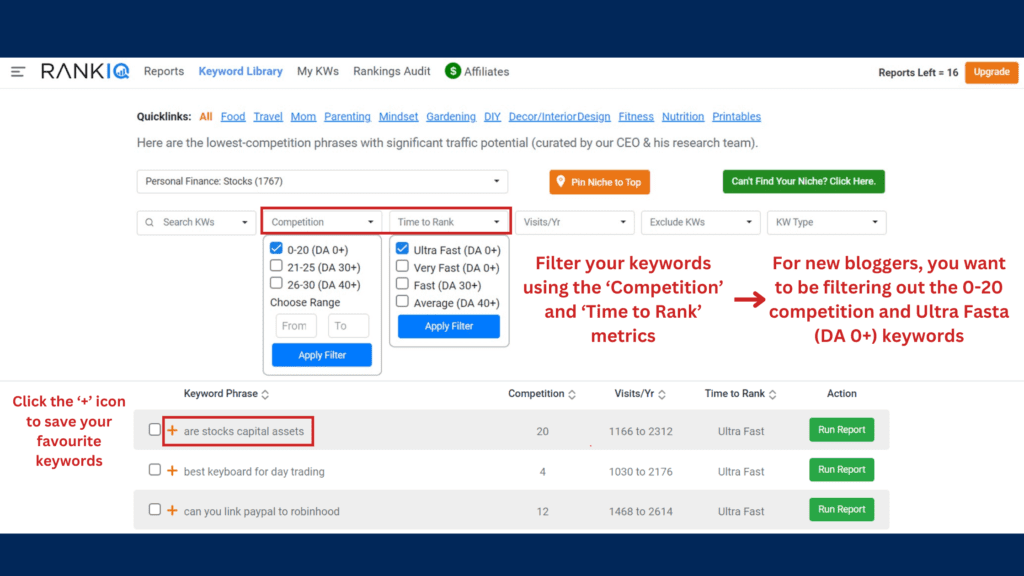
And that’s it.
In a matter of minutes, you’ve identified high traffic potential keywords that will give you the maximum chance of ranking on the first page of Google.
A Note on Domain Authority
You may have noticed from the previous images, that the competition and time to rank metrics are filtered based on domain authority (DA).
Domain Authority is a metric that predicts how well a website will rank on search engine result pages. It scores websites on a scale of 1 to 100, with a higher score indicating a better ability to rank.
DA considers various factors, including the number of linking root domains and the total number of links. Essentially, it offers a quick snapshot of a site’s potential ranking power in comparison to others.
If you’re a new blogger, or even if you have a blog that is a couple of years old, then it’s likely you’re DA score will be less than 20. That’s why in RankIQ, when you’re selecting keywords to rank for as a new blogger, you should filter out only the keywords that have a competition and time to rank DA score of 0-20.
This ensures you are targeting keywords with low competition, meaning it’s more likely you’ll be able to rank on Google for these keywords.
And as a beginner blogger, this is exactly what you want to be doing to drive traffic to your blog.
When you’ve filtered out and added the keywords that you want to rank for to your library, you’re now ready to start the next step of the RankIQ workflow – running a content report.
RankIQ Keyword Library - FAQS
I recommend starting by using the niche finder tool. At the top right-hand side of the Keyword Library section, a green button reads, "Can't find your niche?" Click on this button and type in all the topics in your niche (use one or two-word phrases separated by commas). If you still can not find libraries that cover your niche, you can request a new custom keyword library, where the founder and his team will personally do the keyword research for you: https://www.rankiq.com/library-request/
RankIQ keeps track of every report run on each keyword and delete words from the database as reports are run. We are the only keyword tool that does this.
While many factors go into the competition score, the main driving factor is the number of low Domain Authority (DA) sites ranking on the first page of results and how high these low DA sites rank on the first page.
The actual number of days that it takes for Ultra, Very Fast, Fast and Average varies based on your blog's DA. An Ultra Fast keyword will rank 6 times faster than Average. Very Fast is 3 times faster, and Fast is 2 times faster.
Keyword volume for a single keyword phrase is meant to make decisions on which keyword to go after via Google Ads, not for writing blog posts. As a blogger, you want to be looking at the total Google traffic you will get based on your most likely ranking. This is what RankIQ gives you in the estimated visits per year metric. The visits per year calculates the actual number of visitors driven to the current blog posts ranking on the first page of Google for that keyword phrase. This includes all keyword variations. Keyword volume is just the number of searches on Google that occur each month for that exact keyword phrase.
Step 2: Identify Top Ranking Topics with the RankIQ Content Report
Once you have identified a keyword you want to target in your blog post, the fun begins.
This next feature is by far the most powerful tool that RankIQ offers. The AI SEO report feature.
With RankIQ’s AI SEO report, you’re equipped with a roadmap to become an SEO expert. A roadmap to crafting the perfect post that is optimized for search engines.
To get started, navigate to the keyword library and click the ‘Run Report‘ button that is positioned next to the chosen keyword.
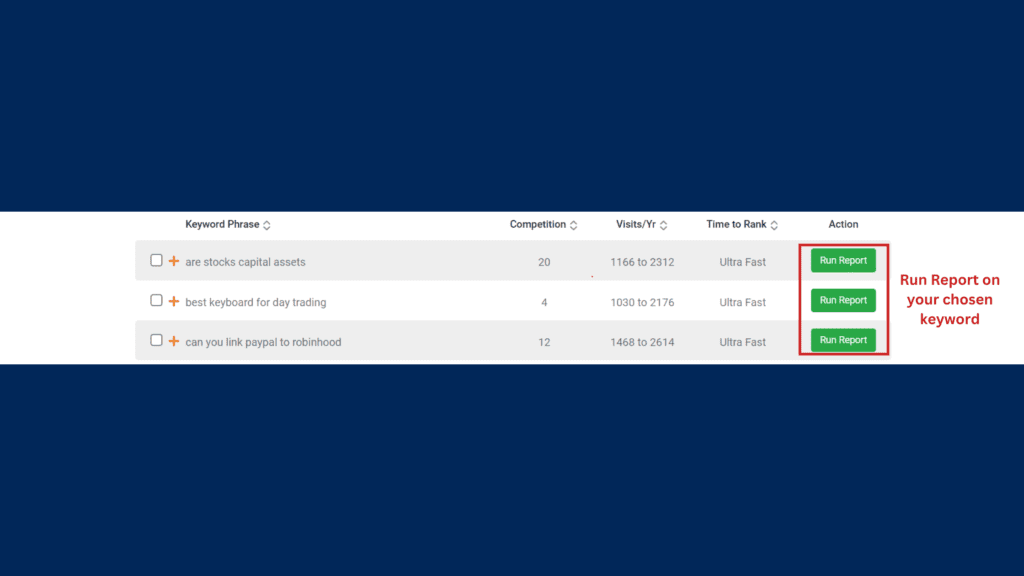
After clicking the Run Report button, RankIQ will take a few moments to generate your report. Once that’s done, you’ll see a page that summarizes the keyword phrase you entered, along with a series of AI-driven suggestions, each with its own purpose.
Let’s discuss these suggestions in more detail.
Content Targets & Google Ranking Analysis
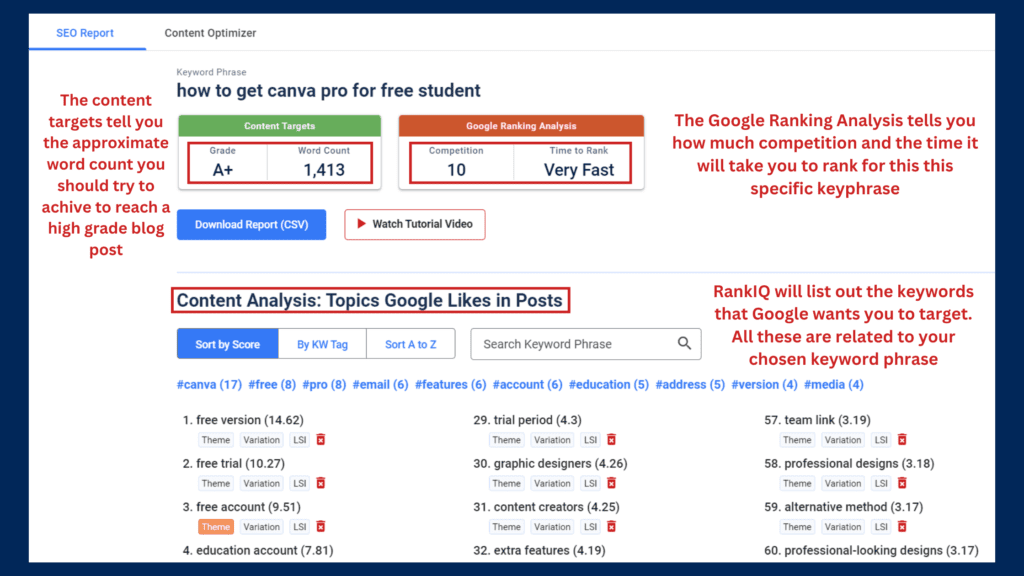
The first section you will notice contains the Content Targets and Google Ranking Analysis.
The purpose of these is to inform you about the suggested word count that you should target in your blog post. This suggestion is based on the specific keyword phrase you entered and the related keywords and themes that you should include in your post.
The purpose of presenting this to you is to ensure that you are on the right track to optimize your content to perfection.
The Grade metric will make more sense when we get into writing your optimized blog post. But in essence, the grade RankIQ rates your blog post for SEO. It’s based on the word count and how optimized your post is for SEO.
It assesses how many keywords and keyphrases you have used that Google wants you to rank for. The word count is an approximation of how long your post will need to be to target those keywords and write content that actually provides benefit to the reader.
If you simply tried to include all the keywords that Google wants you to rank for in a tiny blog post, Google won’t like that.
This is known as keyword stuffing, where you solely stuff your post with keywords for the purposes of SEO.
Google is smarter than that. It knows how to read a bad post that is keyword-stuffed. Instead, you need to be writing valuable content that sheds insights and actually benefits your readers.
That’s the whole point of the content targets section within RankIQ.
Content Analysis
The next core feature contained within the SEO Report is the Content Analysis: Topics Google Likes in Posts.
Distinguishing RankIQ from other platforms is its unique approach to keyword libraries. It doesn’t just cluster similar words; it dives deep into the semantic world of latent semantic indexing (LSI keywords).
LSI keywords are terms and phrases intrinsically linked to your primary keyword. They aid in defining the landscape around your main topic.
They help search engines decipher the essence and context of your content, ensuring it’s placed rightly among billions of web pages. The result? Enhanced content relevance and an uplifted SEO ranking.
RankIQ generates an exhaustive list of all the LSI keywords that are related to the keyword phrase you ran your RankIQ report on.
These are the keywords you want to craft throughout your post so that Google notices you.
You will notice that each of the keywords within the content analysis results can be categorized as either theme, variant, or LSI.
This is known as keyword categorization, and it is one of RankIQ’s standout features. That’s because it brings structure to the often-chaotic world of SEO keyword planning.
Understanding these categories is crucial for bloggers who want to leverage RankIQ to its fullest potential. Let’s dive into the definitions:
Theme Keyword:
- Definition: These are the primary focus keywords or topics that structure your content. It’s the central idea or subject around which your content revolves.
- In Context: When RankIQ identifies a keyword as a “theme”, it suggests that this is a potent keyword you should consider building your article around. It’s often broader than variant or LSI keywords and serves as the main anchor for your content.
- Example: If you’re writing an article about capturing high-quality images, one the theme keywords might be “digital photography.”
Variant Keyword:
- Definition: Variant keywords are alternative phrases or expressions that are very closely related to the theme keyword. They represent other ways people might search for the same topic.
- In Context: RankIQ categorizes certain keywords as “variants” to provide bloggers with a broader scope. While these keywords might have a similar meaning to the theme keyword, they might be phrased differently or focus on a slightly different angle of the same topic.
- Example: If your theme keyword is “digital photography”, variant keywords might include “digital camera techniques” or “digital photo shooting tips.”
LSI (Latent Semantic Indexing) Keyword:
- Definition: We’ve already briefly defined this. But for further context, LSI keywords are terms and phrases that are semantically related to the theme keyword but aren’t necessarily synonyms. They help in providing context and can be seen as topics that are commonly discussed in conjunction with the theme keyword.
- In Context: RankIQ’s identification of LSI keywords provides depth to your content. Incorporating these keywords can enhance the comprehensiveness of your content, ensuring it covers various facets related to the primary topic. Moreover, they help search engines grasp the context of your content, thus improving its chances of ranking higher.
- Example: For the theme keyword “digital photography”, LSI keywords might be “image resolution”, “editing software”, or “photo lighting techniques.”
By meticulously categorizing RankIQ’s keyword analysis into themes, variants, and LSI keywords, you gain a clear blueprint for your content strategy.
This analysis delineates the exact keywords that Google prioritizes. Crucially, these keywords are presented in a hierarchy of significance: the initial keywords being the most vital, followed by subsequent ones in descending order of importance.
By categorizing these keywords into themes, variants, and LSI terms, you can pinpoint the central theme to anchor your content around.
With this foundation set, weave in the variant and LSI keywords, ensuring that your content doesn’t just resonate with search engines but also reads organically and fluidly to your audience.
Overall, the content analysis feature is a great tool that levels the playing field, allowing new bloggers to compete with seasoned professionals with minimal effort required.
The RankIQ Title Generator: Your Key to Engaging Headlines
In the vast digital landscape where content is king, a headline is the crown jewel. It’s the first impression, the hook that draws readers in.
Understanding its importance, RankIQ offers a specialized title generator tool designed to craft compelling and SEO-rich titles.
The RankIQ title generator operates with an advanced algorithm that has analyzed the top-performing titles across the web, enabling it to offer insights into what makes a headline click-worthy.
Upon running a content analysis, the title generator suggests potential keywords and phrases based on their relevance and frequency in top-ranking articles. The keywords are ordered based on their prevalence in top-ranking articles and the weightage Google attributes to them.
The principle is clear: It’s not merely about incorporating keywords but embedding the most impactful ones, aligning your title with robust SEO practices.
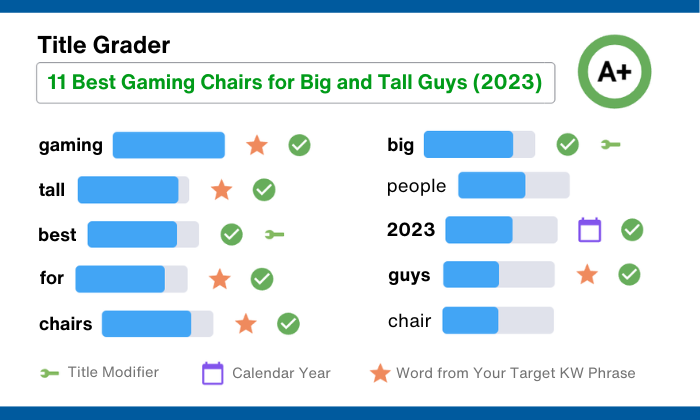
Here’s how RankIQ breaks its title analysis down:
Title Modifiers: Words or phrases that amplify the essence of your title, such as “best,” “free,” or “easy.”
Calendar Year: Incorporating the present year or an associated timeframe to indicate the currency and relevance of the content.
Word from the Phrase: Directly extracted from the keyword phrase the report was derived from, ensuring the core theme of your post is evident in the title.
Uncategorized words in the title generator play an equally significant role. These are words that consistently appear in the top-ranking pages pertinent to your topic. Their inclusion is a nod to what’s currently trending in your niche, optimizing your content for higher visibility.
The genius of RankIQ’s title generator lies in its user-friendly design. Click on a suggested keyword, and it integrates effortlessly into your evolving title. As you shape your headline, the platform provides real-time feedback, rating it based on keyword inclusion and optimal character length.
Just below this ingenious tool, RankIQ unveils another layer of insight with the Top Ranking Titles with Competition Analysis.
Displaying the top 10 reigning articles for your topic, this feature lets you discern patterns and elements that make these titles effective.
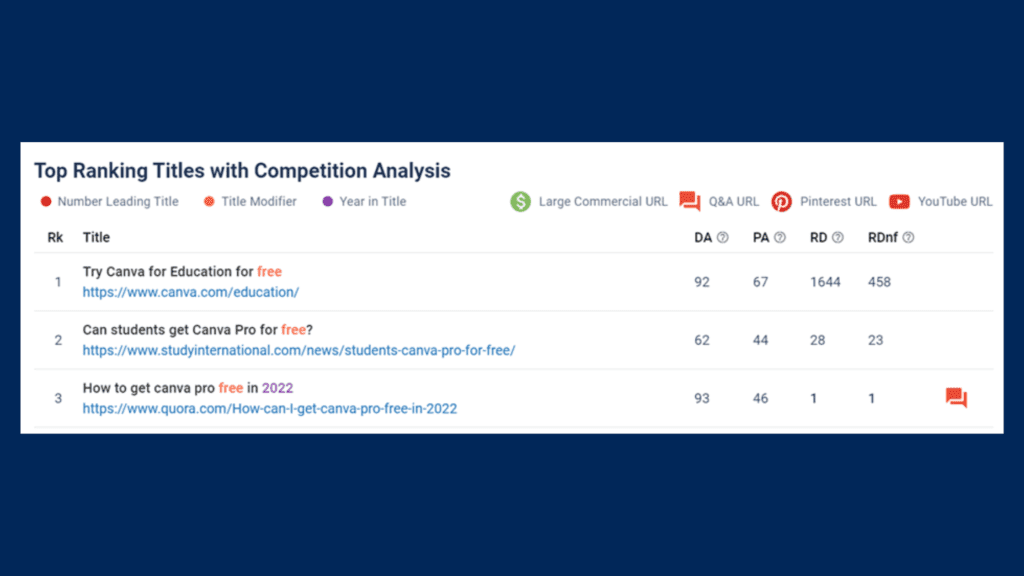
Survey your Competition
Completing the holistic SEO report provided by RankIQ is the Highest Graded Content in SERPs section.
This feature acts as a benchmark, presenting the pages that have not just managed to rank high, but have also exhibited comprehensive content prowess on the topic at hand.
For those aiming to create standout content, it’s not just about getting to the top; it’s about staying there and maintaining relevance.
By studying these high-grade pages, you can glean insights into how the best in the business are structuring their content.
It gives you a tangible sense of the depth, style, and breadth of content that search engines, particularly Google, deem as superior.
Let’s delve into a brief example to understand its utility:
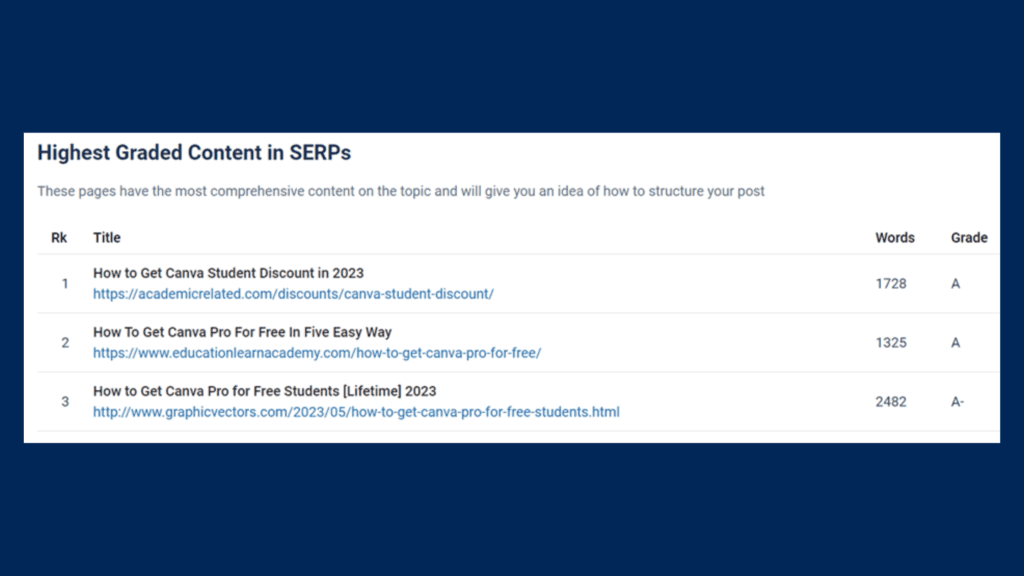
From this snapshot, not only do you get the title and the URL for reference, but you also gauge the word count, giving you an idea about the depth of the content.
The grade, which in this instance is an impressive A, serves as an indicator of content quality, helping you set benchmarks for your own posts.
The integration of this feature in RankIQ’s SEO report ensures you’re not working in the dark.
By studying and even emulating (without plagiarizing, of course) the structure and depth of these top-performing pages, you can carve a path for your content that’s already validated by success in the search engine rankings.
If you can incorporate and expand upon what’s already out there, then your post will be poised to rank highly in Google.
You don’t have to reinvent the wheel. You just need to add value.
It’s a tried a tested method. Use your competitors to create your outline, and then move into optimizing the content of your post.
Step 3: Write your Post with RankIQ's Content Optimizer
At the heart of RankIQ’s prowess is its ability to conduct content analysis and optimize content using the content optimization tool.
While creating engaging narratives is an art, ensuring they’re SEO-friendly is a science, one that RankIQ has mastered.
Your introduction to the RankIQ SEO Report has already set the stage, outlining the foundational structure of your content. But the real magic unfolds when you seamlessly weave in the wealth of data from the report using the content optimizer—a tool that’s every content creator’s dream.
Initiating the content optimizer is a breeze. Upon accessing the ‘Content Optimizer’ tab within the RankIQ interface, you’re presented with a text editor, ready for your words.
While it may resemble a typical text editor at first glance, it’s a powerhouse in disguise, replete with integrated SEO functionalities that guide you towards crafting an exemplary blog post.
Look beyond the conventional text editing features, and you’ll notice the continuously updated content grade and word count, echoing the metrics discussed in the Content Targets segment of the SEO report.
As you pen down your thoughts, be reminded that achieving a commendable grade surpassing A+ isn’t just about hitting the word count but skilfully enveloping the targeted keywords within your narrative.
To your right lies the optimizer’s crown jewel—a comprehensive list of all SEO report-specific keywords Google expects in your post. Once these keywords find their place within your content, they illuminate in green, offering instant feedback.
The potency of this feature can’t be stressed enough. It not only flags if a keyword has been used but also quantifies its mentions. For instance, if a keyword appears three times, a ‘(3)’ will mark its frequency.
Gone are the days of laborious ‘Ctrl + F’ searches; a single click on the keyword, followed by the ‘highlight‘ button, reveals its presence across the content. Further refining your strategy, the panel delineates if the keyword aligns with the themes, variants, or LSIs you previously categorized during the SEO report phase.
Here’s the content optimizer in action:
- Launching it post an SEO report reveals an untouched canvas.
- But as you paint your words, taking cues from your targeted keywords, both word count and grade flourish. By staying within the suggested word range and integrating theme and variant keywords, you’ll likely see grades ranging from A to A++.
- While the recommended word count provides guidance, there’s no ceiling to excellence. The content shown in the example image displayed an A++ grade for 3,124 words, surpassing the advised 1,413. So, if you have more value to add, exceeding the word count might very well be in your favor.
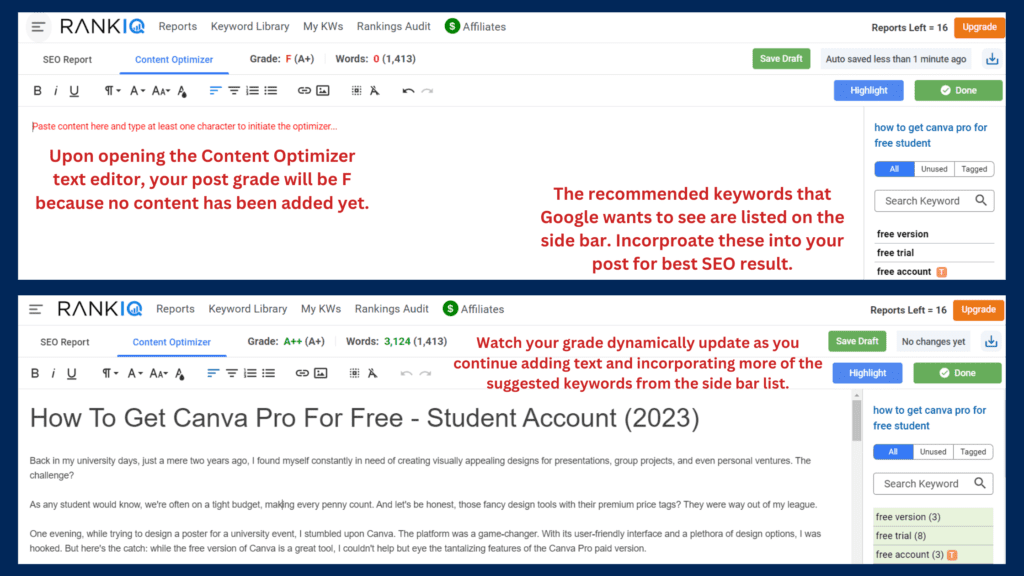
Personally, the content optimizer is what I think separates RankIQ from other SEO tools.
The incredibly basic user interface focuses only on what is truly important. And as a beginner blogger, that’s all I want. I don’t need the fancy bells and whistles that other SEO tools like Semrush or ahrefs offer.
I don’t know enough about SEO to leverage these ‘nice to haves’ anyway.
To me, RankIQ solves my biggest problem. Finding the right keywords and ensuring they are incorporated. And although this next insight isn’t actually provided by RankIQ, it’s used in combination to elevate your SEO game.
It’s my secret weapon to writing SEO-optimized posts. So brace yourself.
Bonus Insights from the Author: Supercharging SEO with RankIQ & ChatGPT
RankIQ, on its own, is an exceptional tool designed to empower bloggers with game-changing SEO insights. It meticulously breaks down the intricacies of keywords, content optimization, and SEO titles.
However, to truly maximize efficiency in blog post writing and elevate your content to unprecedented SEO heights, there’s an additional ace up the sleeve: ChatGPT.
When combined, these two create an unstoppable duet, unparalleled in crafting content that’s not only engaging but perfectly aligned with SEO requirements.
Here’s my secret step-by-step guide to uncover the dual power of both tools.
In RankIQ:
- Keyword Research: Embark on a journey of exploring and analyzing to discover the most impactful keywords.
- Selecting the Right Keyword: With a treasure trove of possibilities, pinpoint the ideal keyword that resonates with your content goals.
- Generating the SEO Report: Harness the power of RankIQ’s report to gain a comprehensive roadmap for your content.
- Decipher the Word Count: Jot down the suggested word count, ensuring the content is appropriately sized.
- Crafting the Ideal Title: Utilize RankIQ’s advanced title generator to curate a captivating, SEO-optimized title.
In ChatGPT: Armed with RankIQ’s insights, pivot to ChatGPT and channel its capabilities to transform strategically crafted prompts into a captivating content outline. Prompt ChatGPT with:
- Blog Post Title: Introduce the striking title you’ve fashioned.
- The Main Keyphrase: Reiterate the primary theme your blog will revolve around.
- RankIQ’s Keyword Recommendations: Input the list of essential keywords Google prizes. Request the engine to integrate them naturally and contextually into the outline, emphasizing SEO optimization.
- Word Count Goal: By designating the desired word count, you guide the engine to craft content that is both detailed and succinct.
- Craft Your Blog Post: With your content outline defined, prompt ChatGPT to write each section for you. It will have recorded all the keywords to use based on your previous prompts, so not only will you have your post written for you, but you’ll also have it written in a way that is optimized for search engines.
- Copy your new blog post into RankIQ: With your completed blog post in hand, copy and paste it into the RankIQ content optimizer text editor. If it hasn’t already achieved an A++ grade, manually tweak it and add in your personal touches to ensure it reads like a human wrote it.
Achieving SEO Supremacy with the Ultimate Partnership: RankIQ lays the strategic foundation, providing the tools and insights to navigate the vast world of SEO.
ChatGPT, with its unrivaled content generation ability, builds upon this foundation, optimizing for SEO and crafting narratives that resonate.
This synergistic pairing ensures your blog posts aren’t just meticulously researched and structured but also creatively expressed, giving you a clear edge in the competitive blogging landscape.
With RankIQ and ChatGPT, you’re wielding a duo that seamlessly bridges the gap between SEO analytics and eloquent storytelling. It’s an unfair advantage, waiting at your fingertips.
No matter what the recommended grade is, I always add content until I reach an A++. This is recommended by the the founder of RankIQ.
You can run a report on any phrase by clicking on the "Reports" link in the main navigation at the top of the page. Just enter your keyword and click the "Run Report" button.
Practical Tips for Using RankIQ Effectively
We’ve now addressed the core components of how RankIQ works.
But like any other tool, RankIQ efficacy is best gauged when employed strategically.
Below, we’ll navigate through practical ways to leverage RankIQ for both new posts and old posts, ensuring your blog not only survives but thrives in the digital realm.
Crafting New Posts with RankIQ's Guidance
Navigating the unpredictable waters of blogging can be daunting, especially when you’re new to the field or when you’re struggling to see substantial traffic.
However, many successful bloggers have leveraged RankIQ’s potential to catapult their blogs into the spotlight. Here’s a practical guide tailored from their success stories:
Preliminary Keyword Research: Before drafting, immerse yourself in RankIQ’s extensive keyword library.
Identify those low-competition keywords that align with your niche. The most successful bloggers have been known to focus on phrases with a competition score ranging from zero to 24, harnessing the full potential of RankIQ’s monthly reports.
Consistency is Key: Those that witness the most significant growth often adopt a diligent writing approach. Some even push out a new post daily for half a year.
If daily seems rigorous, aiming for at least three quality posts a week is a good benchmark.
Beware of Common Pitfalls: It’s easy to drift towards topics that resonate personally with you. However, if they aren’t SEO-friendly, you risk stagnation.
It’s vital to prioritize topics that not just appeal to you, but are also poised to rank. While the occasional passion-driven post outside the keyword library is fine, ensure the majority resonate with RankIQ’s recommendations.
Patience Pays Off: Blogging is no sprint; it’s a marathon. Initial months might seem unrewarding, with substantial traffic growth sometimes taking up to half a year post-publishing. Yet, it’s imperative to stay the course. Abandoning strategies or tools prematurely is a common blunder.
True blogging success, both in traffic and income, often materializes after consistent efforts spread across a couple of years.
SEO-centric Drafting: With your researched keywords, weave your narrative. The emphasis here is on organic integration, ensuring the story remains captivating and coherent.
Continuous Monitoring: Post launch, keep a vigilant eye on performance metrics. If they’re falling short of expectations, recalibrate and adjust based on the insights RankIQ provides.
Avoid Over-Niching: While niching can give you a distinct voice in the blogosphere, going too narrow can hinder your growth potential.
Aim to be more generic like the “Wig Blogger” rather than confining yourself to a super-specific niche like “short red-haired wig blogger for women over 40”.
An analysis reveals certain niches that boast numerous blogs with impressive traffic, often exceeding 50,000 monthly sessions. Exploring these niches might be worth your time.
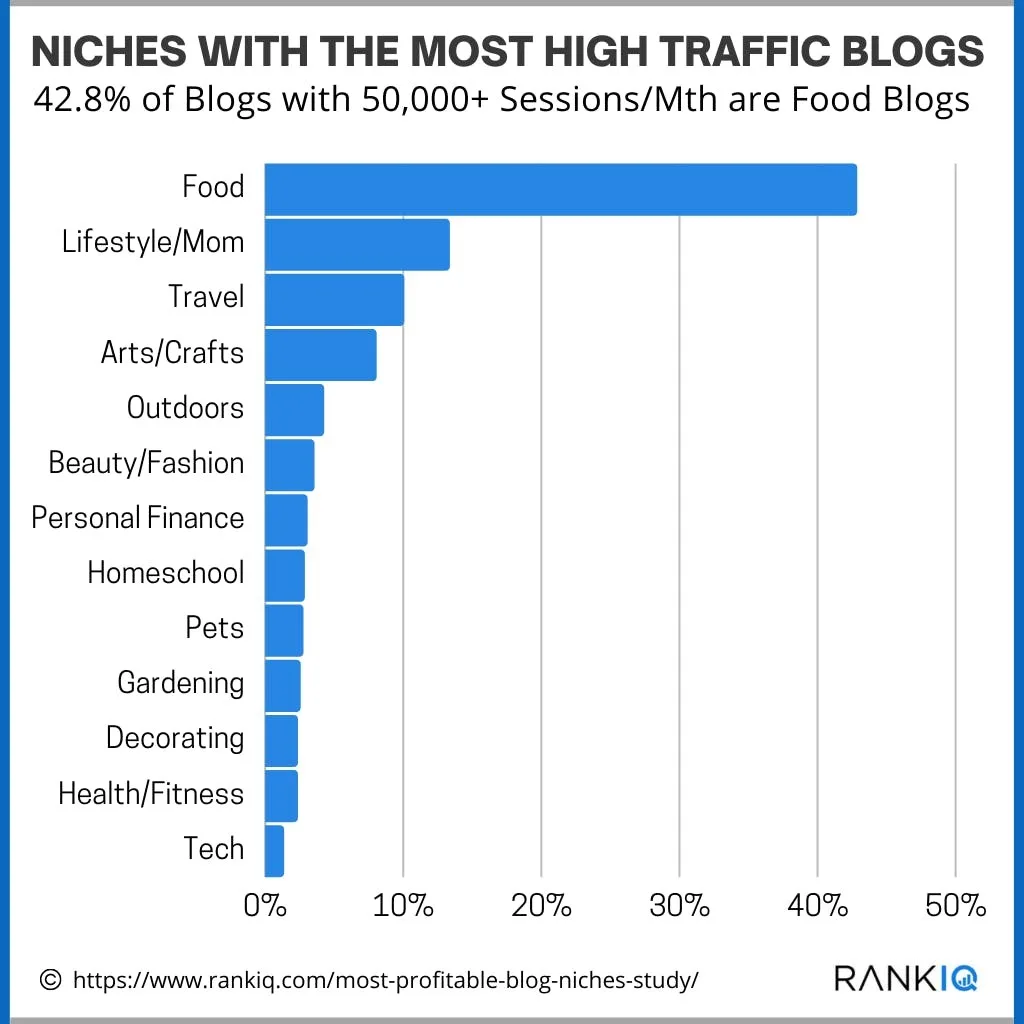
Updating Old Posts for Better SEO - RankIQ's Rankings Audit
RankIQ has one more powerful tool we haven’t spoken about yet – the Rankings Audit tool.
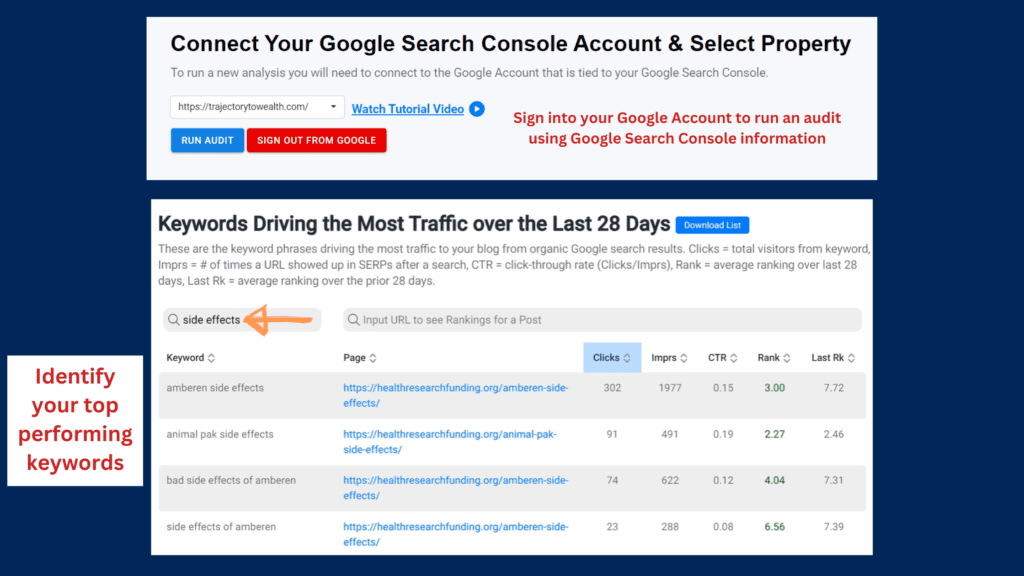
The Rankings Audit tool by RankIQ offers a direct connection to Google Search Console (GSC), providing bloggers and content creators with a more refined and efficient way to assess their website’s performance.
Although you might think this tool doesn’t add any benefit beyond the standard Google Seach Console platform, RankIQ extends the insights and features a standard GSC interface would provide.
Here’s how:
Extended Keyword Access: While the default Google Search Console provides data on 1,000 keywords, RankIQ, through its API connection, grants you insights into 3,000 keywords. This extended access ensures you’re not missing out on potential traffic-driving keywords.
Searchable Database: With RankIQ, you can effortlessly search by specific keywords. This feature is particularly beneficial when you want to assess the performance of targeted keywords or when planning content around specific terms.
Instant Post Rankings: Want to know how a particular post is performing? RankIQ allows you to quickly view the rankings of any post, helping you identify which articles are doing well and which ones need optimization.
Consolidated Data Analysis: Instead of toggling between multiple pages and reports, RankIQ consolidates vital data onto a single page. This streamlined approach saves you time and ensures you get a comprehensive view of your site’s performance at a glance.
Authentic Data Source: Unlike many SEO tools that rely on web scraping for ranking estimates, RankIQ utilizes data directly from Google Search Console. This ensures you’re basing your strategies on legitimate, up-to-date data rather than potentially outdated estimates from web scraping.
By leveraging the insights from the RankIQ Rankings Audit, you are equipped with a powerful tool to:
Identify Underperforming Content: Use RankIQ to spot your old underperforming posts. These are the pieces with valuable insights but are not getting the attention they deserve.
Re-optimize and Update: Integrate trending keywords and relevant updates to these old posts. Remember, it’s not just about adding keywords, but ensuring the content remains accurate and current.
Re-promote: Once updated, don’t let them sit idle. Promote them as you would with any new content.
Reviving old posts with the guidance of RankIQ can drive more organic traffic without the need to constantly create fresh content.
The Long-term Vision with RankIQ
While instant results can be enticing, SEO, at its core, is a marathon, not a sprint. For the long run, RankIQ can be your steadfast companion.
Focus on Domain Authority: A higher domain authority gives your site a better chance to rank well across all content. RankIQ’s insights can help boost this over time.
Consistency is Key: Regular updates and consistent quality content will give you the best chance of establishing a reputable online presence.
Stay Updated with Trends: SEO isn’t static. What works today might not tomorrow. With RankIQ, you stand a good chance of staying ahead of these evolving dynamics.
RankIQ Pricing: A Detailed Look into Value, Features, and Flexibility
RankIQ operates on a tiered pricing structure, tailored to accommodate different levels of content production needs.
Irrespective of the chosen plan`, every subscriber gets unfettered access to RankIQ’s core offerings. The distinction between the tiers is solely in the number of SEO reports you can run.
Every RankIQ subscriber benefits from:
- Keyword Research: Dive deep into keyword trends and discover which phrases have the potential to elevate your content’s visibility.
- SEO Reports: Offering detailed insights that align your content with Google’s preferences.
- Intuitive Title Generator: Equip yourself to craft SEO-aligned headlines that capture attention.
- Content Optimizer: Seamlessly optimize your content to resonate with search algorithms and your readers alike.
- Rankings Audit: Gain actionable insights into your website’s performance and discover areas of improvement
- Access to Mastermind Group: Beyond the tools, subscribers gain entry to a Mastermind group. This community serves as a reservoir of recommendations on maximizing the utility of RankIQ. It’s also a direct line to the brain behind RankIQ – Brandon Gaille. Pose questions, seek guidance, and get acquainted with best practices from the founder himself.
Here’s a breakdown of the subscription tiers and RankIQ pricing structure:
Standard Plan – $49/month:
- Frequency: Designed for individuals or new ventures, this plan allows 16 AI SEO Reports per month.
Pro Plan – $99/month:
- Frequency: Suited for dedicated content creators or growing businesses, it offers 36 AI SEO Reports each month.
Agency Plan – $199/month:
- Frequency: Ideal for larger teams or agencies, this plan provides a substantial 80 AI SEO Reports monthly.
RankIQ’s pricing structure is crafted to ensure you only pay for what you need, allowing you to select a plan that aligns perfectly with your content production demands.
When it comes to keyword research and SEO tools, RankIQ holds its own, even when placed alongside industry heavyweights like Ahrefs or SEMRush.
What truly differentiates RankIQ, in my opinion, is its bespoke design for bloggers and small businesses. There’s no prerequisite to be an SEO expert to harness the power of RankIQ.
In contrast, platforms like Ahrefs and SEMRush often demand a more intricate grasp of SEO for optimal utilization. This user-friendly approach is precisely why RankIQ resonates so deeply with me.
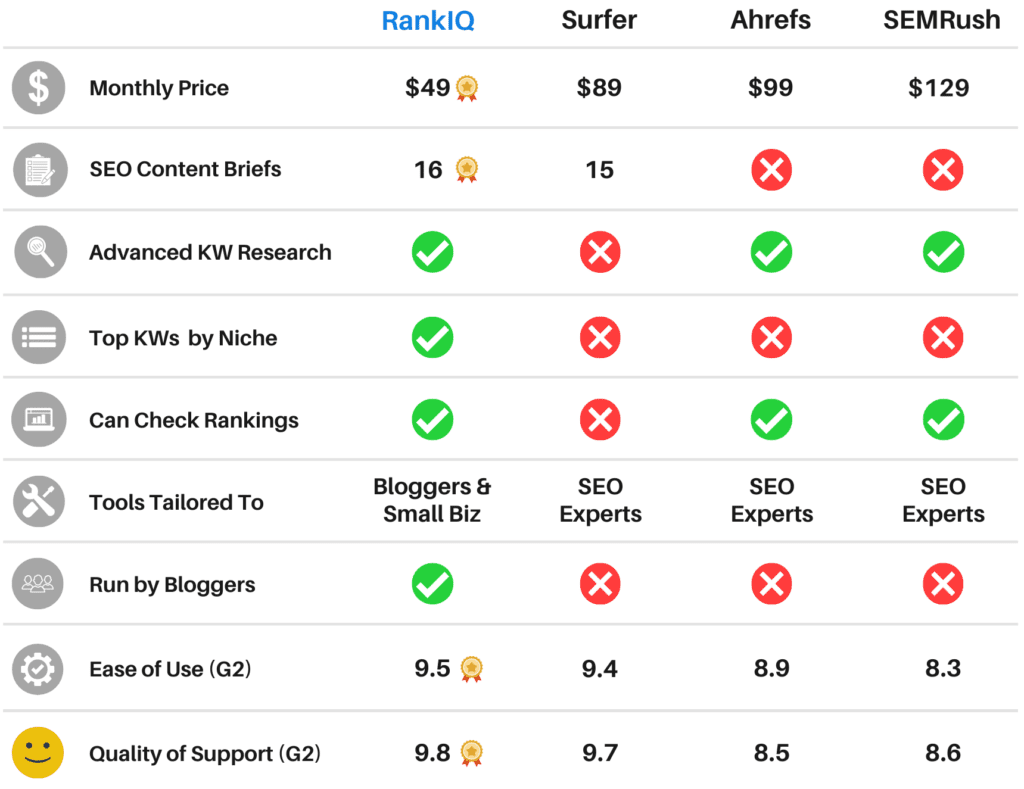
RankIQ Pricing Plans
Get the lowest competition high traffic keywords in your niche (handpicked by top experts) Simple & easy to use SEO tools that deliver first page rankings. Sign Up Online.
The Not-so-Good Features of RankIQ
A RankIQ review wouldn’t be complete if I didn’t mention the things that I don’t love about the SEO tool.
Every tool, no matter how revolutionary, is bound to have a few chinks in its armor. While RankIQ proves to be an instrumental SEO companion for many, it’s worth noting the aspects of it that don’t shine as brightly.
Here’s my candid take on the not-so-good features of RankIQ:
Absence of AI-Assisted Content Creation: While RankIQ shines in SEO analysis, it doesn’t provide an AI-assisted language model for content creation. This means while you get the SEO insights, the actual content creation remains on you. However, this limitation hardly deters me as I leverage ChatGPT for this very purpose, ensuring I always have a reliable assistant for creating captivating narratives.
Restrictions on the Number of Reports: The tiered model RankIQ employs – offering 16 reports for standard users, 36 for pro users, and 80 for agency users – could be restrictive for some, especially as each tier comes with an increasing price tag. While my content frequency doesn’t exceed 16 posts a month, it’d be advantageous to have the flexibility of running reports on more keywords, particularly if I decide to not proceed with writing a blog post outline. Although this is a double-edged sword, because this current system places a premium on accurate keyword selection right from the get-go, which is a good habit to build.
Exclusively a Desktop Affair: The absence of a mobile app version means RankIQ is strictly a desktop/browser tool. For bloggers who thrive on mobility, this could pose a limitation. However, my personal workflow is desktop-centric, especially when penning extensive blog posts, so this particular aspect doesn’t hinder me much.
Limited Niche Coverage: RankIQ, though extensive, doesn’t cover all conceivable niches. While my focus on personal finance and online side hustle opportunities finds ample representation, ultra-niche areas might feel left out. However, RankIQ’s adaptive approach shines through here. They allow users to submit custom keyword requests, which their dedicated team reviews and potentially adds to the library, ensuring evolving coverage.
In wrapping, while these features might seem like potential drawbacks, we have to appreciate that no tool is perfect.
It’s the overall value proposition and how you utilize it that truly counts.
FAQ Section for Mastering SEO with RankIQ
RankIQ is a cutting-edge search engine optimization tool designed to simplify SEO for bloggers. It offers features like a keyword research library, content optimization guidance, and title grading, ensuring that your content has the best chance to rank high on search engines, especially Google.
Targeting the right keywords, especially low-competition and high-traffic keywords, ensures your content has the highest traffic potential. This increases the likelihood of your blog posts being found by your target audience, leading to more page views and potential revenue.
RankIQ can analyze old posts and provide insights on how to update them for better SEO. This includes suggestions on title modifications, keyword enhancements, and content restructuring to maximize their performance.
Absolutely! RankIQ offers guidance tailored for new posts, ensuring that from the onset, your content is optimized for the best search results. This guidance can be in the form of keyword suggestions, content grade evaluations, and more.
The title grader is a unique feature that evaluates your page title's SEO potential. A well-optimized title can significantly impact your content's visibility on search engines, and this tool ensures your titles are catchy and SEO-friendly.
Yes, RankIQ offers a collection of tutorial videos designed to help users understand its features better. These concise, well-structured videos provide clarity on using the tool effectively for both new and experienced bloggers.
RankIQ operates on a subscription model at $99/month. However, there's an introductory offer at just $49/month, granting full access to their comprehensive keyword library and 16 monthly AI SEO reports that refresh each month.
Brandon Gaille is the host of the Blogging Millionaire Podcast and is known as a top blogger in the industry. His insights and expertise are often integrated into RankIQ, adding immense value to the tool.
While RankIQ primarily focuses on content optimization, consistently producing high-quality content, as guided by RankIQ, can contribute to improved domain authority over time.
Yes, RankIQ is designed to be user-friendly for those new to SEO, while also being robust enough to offer value to seasoned SEO experts. Its ease of use combined with in-depth analytics makes it a great tool for all skill levels.
Conclusion: Simplifying SEO, the RankIQ Way
Navigating the intricate maze of SEO can be daunting, especially for new bloggers. We’re often caught in the crossfire of creating quality content and ensuring it’s optimized for search engines. Enter RankIQ – a tool that promises to bridge this gap with the power of artificial intelligence.
Having delved deep into its features, analyzed its workings, and compared it with other tools in the market, it’s evident that RankIQ brings a fresh perspective to the SEO table. Its AI-driven insights, comprehensive keyword library, and intuitive content optimization features make it a valuable ally for bloggers at any stage of their journey.
But what truly stands out is its dedication to new bloggers. The challenges we face are unique – from understanding the nuances of SEO to competing with established websites. RankIQ acknowledges these challenges and offers tailored solutions, making the daunting task of SEO a tad bit more approachable.
In the ever-evolving world of blogging, tools come and go. But RankIQ, with its innovative approach and commitment to user success, seems poised to leave a lasting mark. As a fellow new blogger, I can attest to the difference it has made in my blogging journey. And while no tool can guarantee overnight success, RankIQ certainly provides the right arsenal to set you on the path to SEO victory.
To all my fellow bloggers out there, especially those just starting out, I wholeheartedly recommend giving RankIQ a try. It might just be the game-changer you’ve been waiting for.
Unlock the Future of SEO Optimization With RankIQ
Ready to elevate your SEO game? Discover the full potential of RankIQ for yourself.

